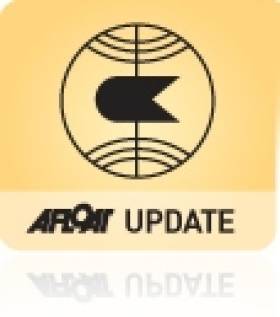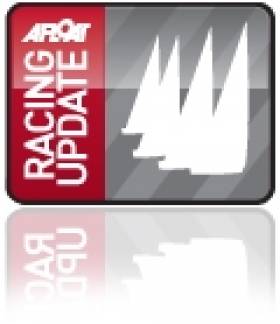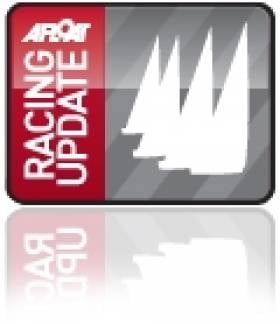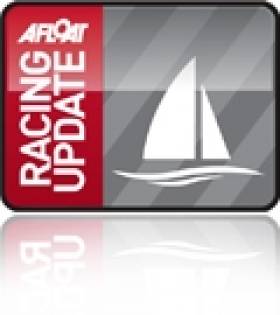Displaying items by tag: OK Dinghy
Nick Craig Wins Sixth OK Dinghy World Title in Brisbane
Nick Craig has won his sixth OK Dinghy World Championship after a tight week of racing at the 2024 Tan Lines OK Dinghy World Championship, hosted by Royal Queensland Yacht Squadron, in Brisbane. Despite a tough last day, there was no change in positions, with Andy Davis taking second while Roger Blasse was third.
As Afloat reported earlier, Greystones Harbour ex-pat Sean Cleary, now sailing for New Zealand, ended the championships in 25th place having been as high as ninth.
The final day was sailed in the best conditions of the week, with winds up to 14-16 knots, 30 degrees, blue skies, some nice waves, and fantastic weather.
Craig took a nervous third in race 9, followed by an emphatic second in the final race to secure a record sixth world title in the class. Andy Davis (who was Shane MacCarthy's crew when he sailed to GP14 world Championship success in 2016) placed fifth in the first race and then gave Blasse, with whom he was tied on points, a tough time in the second to hang onto the silver after Blasse had won the first race. However, Blasse picked up a second yellow flag while under a lot of pressure from Davis, and all that was needed was for Craig to finish top nine, which he did with ease as the wind increased to 16 knots. The final race was won by Steve McDowell. It was an incredible end to an awesome week in Brisbane.
Glenn Williams won the silver fleet from Brett Daniel and Oscar Paulich.
The prizegiving was held Saturday evening at the Royal Queensland Yacht Squadron with a plethora of prizes handed out.
Royal Irish's Tim Goodbody Lying Fourth at OK Dinghy European Championship
Britain’s Nick Craig has taken the lead at the 2023 OK Dinghy European Championship on Lake Garda with Charlie Cumbley in second, Germany’s Jan Kurfeld in third, and Dun Laoghaire Olympian Tim Goodbody Junior fourth (racing under Spanish sail insignia) with just one day left to sail.
There are 115 entries from 15 nations.
The third day started with light rain, cloud cover and little hope of racing, but by 10.00, conditions had improved, and in the end, it was the best day of racing so far with three more fantastic races in 10-18 knots, sunshine and beautiful conditions.
While many of the leaders struggled in the first race after a big right shift, Craig took the next two race wins in the gold group to lead into the final day by three points. Cumbley scored 3-9-4 to move up to second, while a 2-6-8 from Kurfeld dropped him to third.
In the silver fleet, the race wins went to Britain’s Simon Cox, Germany's Niels Timm and Sweden’s Thomas Uziel.
Highlights from Day 3
Race 6
Bo Petersen is in seventh overall. “It’s always special here. The wind comes after lunch, and then we go sailing. It’s nice to have a regatta when you have the morning and take it calm and be ready. Garda is a nice place for sailing.
“I just turned 60, and Garda is windy, and I am small. I can feel my age. I am still a horse when I am out here, but in the evening, need some pils.”
On the racing, “Ups and downs. The first three races were easy, and then I had a bad one. Sometimes it is tricky out there. Today, my watch stopped, and I had a bad start and went left. It’s been a tough day, but a lot of guys also had a bad race so looking forward to seeing the results.”
Craig said, “Good overall. First race was poor. The windward mark was left, so I thought left would pay, so I got out left and rounded the first mark fifth from last.
“So the day didn’t start well, but then I won the next two, so didn’t make that mistake again and went right in the next two races.”
Craig has sailed on Garda in a number of classes but, “I’ve been looking forward to this for a long time. It’s great to sail in a huge fleet and great the sail in the OK against a really high-standard fleet. All the things I know about Garda were useful apart from the first race today."
Tim Goodbody of the Royal Irish Yacht Club, but now based in Spain, scored a 27-3-2 and is in fourth overall.
“In Race 1 I started near the pin, but no one wanted to tack so we went left, and it never really came back. About seven of us in the top ten were almost last, but we climbed back up to mid-fleet. Next race I was third, a bit tricky, but kept working the right, and in the last, Nick and I had a good battle, and I had a second.
“It’s always amazing here. I didn’t think the wind would be that good, but it just came out of nowhere, and it was perfect Garda conditions.”
The championship concludes on Thursday with two more races scheduled.
Results after eight races (download full results below as a pdf)
1 GBR 2261 Nick Craig 16
2 GBR 6 Charlie Cumbley 19
3 GER 18 Jan Kurfeld 24
4 ESP111 Tim Goodbody 28
5 GBR 2279 Matt Howard 28
6 DEN 12 Jens Eckardt 36
7 DEN 21 Bo Petersen 45
8 GER 71 André Budzien 46
9 SWE 100 Thomas Hansson-Mild 50
10 DEN 24 Steen Christensen 53
OK Dinghy Numbers on the Rise
OK Dinghy numbers in Ireland are on the up. Another boat has arrived at the Royal St. George YC in Dun Laoghaire and another is expected to finish construction next April.
Bay sailor Hugh Sheehy has being leading the charge in the solo class and is a regular Dulin Bay Sailing Club (DBSC) competitor.
The International OK Dinghy is a 4m long single-handed sailing racing dinghy with fleets in 13 countries including the UK. The OK dinghy site is here.
The latest Dublin boat is a wooden hull. Newer boats are typically built in foam sandwich, so this one has an unusual appearance.
The new boat did a shakedown cruise to check all the systems.
A boat is under construction by well known dinghy sailor Trevor Fisher, which is expected to hit the water in the Spring. Other sailors are looking at the possibility of bringing in second hand boats from the UK.
Goodbody Finishes Second at OK Europeans
The final round brought sunny skies and high temperatures, but more of the same shifty, tricky winds that have plagued the week. Bartosz Rakocy (POL) took the title with a fifth place in race nine, while Tim Goodbody (IRL) took second and Jorgen Lindardtsen (DEN) took third.
Black Flag Not OK for Goodbody
Irish sailor Tim Goodbody was one of six sailors to suffer under the black flag at the OK Dinghy Europeans in Medemblik yesterday. The result in race five, followed up with a second place in race six, puts Goodbody in fourth overall, just five points off the top three.
After a second shifty offshore breeze day, Batozs Madrcoy continues to lead the OK Europeans in Medemblik, Netherlands. Jorgen Lindhardtsen moves up to second with race six race winner Greg Wilcox (NZL) in third after six races.
The forecast of stronger winds were not accurate and day three was sailed in 8-12 knots of shifty offshore winds with 20-30 degree shifts upsetting at least half of the fleet,
The left hand side was generally favoured in race five and was led from start to finish by the overnight leader Rakocy to cement his lead at the top of the scoresheet. Jorgen Lindhardtsen (DEN) finished second and day one leader Terry Curtis (GBR) refound his earlier form to finish third. The race was perhaps defined by the number of black flags including front runners Tim Goodbody (IRL), Pawel Pawlaczyk (POL) and Antoni Pawlowski (POL), which has significantly changed the overall ordering.
Race six was characterised by a large right shift on the first beat and a large left shift on the second beat which left the leaders laughing and the tail enders hoping.
Racer winner, Greg Wilcox (NZL) said, "It was another tricky day. There was quite a big left hand shift at the start so I was pretty sure it was going to come back so I started at the boat end and went right and when it came back I flipped and worked up the shifts up middle right hand side with Tim Goodbody (IRL)." At the top mark Goodbody led from Wilcox and Rakocy.
"Tim and Bartosz dragged each other a bit high in the second reach and I got through to leeward of them. I extended a little bit up the second beat and the three of us left the fleet behind. They then shortened the run which made it a bit easier with Bartosz sitting on Tim down the run." Goodbody finally finished second to Bartosz in third.
"It was the kind of the day when a lot of people made one mistake too many and paid a big price for it, especially with the black flags. It was the 'moving day' - you either consolidate what you have done or move backwards. Today was that day."
After six races one discard has now kicked in. Rakocy had a very good day with a 1-3 to move into a ten point lead and Lindhardtsen, the 1978 World Champion and 1998 European Champion, also had a good day with a 2-5 to move into second overall and. After a 5-1, Greg Wilcox, the 2002 World Champion, moves into third overall.
Racing continues to Friday with four more races scheduled. On Wednesday night the sailors enjoyed free beer night at the Brakeboer pub by the quayside. With the sailing causing enough sore heads, a few more will not make any difference.
Bullet for Goodbody in Medemblik
Tim Goodbody of the Royal Irish Yacht Club took a gun at day two of the OK Dinghy European Championships in Medemblik, Netherlands. The weather produced a late finish after a complete change in conditions with very unstable offwind winds mixing up the results, with most of the leading contenders picking up a high score.
Race three got underway at 13.30 in about five knots after an earlier attempt was postponed and the fleet sent ashore to wait for the wind to build. At the start much of the fleet immediately had to tack onto port as no one could cross on starboard and this was a hint of things to come.
Most of the favourites headed to the left hand side towards a big black cloud but after one third of the beat, a 60 degree shift to the right gave the other half of the fleet a massive lead over the left side. The regatta leaders Terry Curtis, Tim Goodbody and Antoni Pawlawski were all on the left and paid a heavy price for this.
Race winner Thomas Glas said, "I started in the middle of the line and then there was a big right shift. Andreas Pich (GER) led round the top mark followed by Christian Hedlund (DEN), Jurgen Illers (GER) and myself.On the last beat Christian and Andreas went to the right and were fighting together so I went left of the fleet and got a lift which took me into the lead and I won by about 50 metres." Glas rounded off an excellent day with a ninth to end the day in ninth overall
He added, "Today was really tricky sailing, especially with the big shifts in the first race."
The wind increased slightly for race four and still very shifty. The left side did pay this time with Neil Goodhead (GBR) and Martin Bower (GBR) leading round the top mark from the left corner and Alistair Deaves (NZL) in third from the right. Goodhead maintained his lead to the leeward mark and then Tim Goodbody (IRL) made his move, taking the lead at the top of the second beat from Bartosz Rakocy (POL) and Deaves with the wind now at 12-15 knots.
Goodbody extended down the run to lead to the finish. Rakocy sailed well to record another second place to the take the overall lead while Jorgen Lindhardtsen recovered from an average first beat in race four to finish third and move up to third overall. Pawel Pawlaczyk (POL) continued his consistency to end the day in second overall. Overnight leader Terry Curtis (GBR) posted a 33 and 27 in the shifty conditions to drop to 12th overall, while Goodbody also picked up a 23 in race three.
All apart from four out of the top 10 have posted high scores so far, so after Wednesday's two races, the discard should considerbly change the order at the top.
| No | Sailno | Name | Scores | R1 | R2 | R3 | R4 |
|---|---|---|---|---|---|---|---|
| 1 | POL 19 | Bartosz Rakocy | 18,0 | 2 | 10 | 4 | 2 |
| 2 | POL 14 | Pawel Pawlaczyk | 22,0 | 7 | 2 | 7 | 6 |
| 3 | DEN 1364 | Jørgen Lindhardtsen | 29,0 | 8 | 4 | 14 | 3 |
| 4 | IRL 10 | Tim Goodbody | 31,0 | 6 | 1 | 23 | 1 |
| 5 | NZL 522 | Greg Wilcox | 34,0 | 5 | 8 | 9 | 12 |
| 6 | GER 693 | Martin von Zimmermann | 41,0 | 11 | 16 | 6 | 8 |
| 7 | POL 31 | Antoni Pawlowski | 46,0 | 1 | 7 | 28 | 10 |
| 8 | GER 747 | Andreas Pich | 46,0 | 9 | 22 | 2 | 13 |
| 9 | GER 731 | Thomas Glas | 53,0 | 13 | 30 | 1 | 9 |
| 10 | GER 717 | Oliver Gronholz | 60,0 | 10 | 25 | 21 | 4 |
Goodbody Second at OK Europeans
Former Olympic Finn sailor Tim Goodbody lies in second place after day one of the OK Dinghy Europeans in Medemblik. 67 sailors from 11 nations are taking part in the event. Two races were held in a solid force 3-4 with a few rain storms passing over providing some interesting wind shifts. With two third places, Terry Curtis (GBR) leads from Tim Goodbody (IRL) and Antoni Pawloski (POL)
In the first race, Pawel Pawlaczyk (POL) led round the top mark from Antoni Pawlowski (POL) and Alistair Deaves (NZL). On the final beat Pawlowski maintained his lead with Rakocy in second and Curtis climbing to third, with another Pole Marek Jarocki (POL) finding a big shift to place fourth just ahead of Deaves in fifth.
The wind increased for the second race with Dublin Bay newcomer Tim Goodbody leading from start to finish.
Racing continues until Friday 30 July.
Results after 2 races
1. Terry Curtis, GBR, 6
2. Tim Goodbody, IRL, 7
3. Antoni Pawlowski, POL, 8
4. Pawel Pawlaczyk, POL, 9
5. Bartosz Rakocy, POL, 12
6. Jorgen Lindhardtsen, DEN, 12
7. Greg Wilcox, NZL, 13
8. Rene Joahnnsen, DEN, 26
9. Robert Deaves, POL, 26
10. Bo Teglers, DEN, 27
Goodbody 'Newcomer to Watch' in OKs
Irish Finn sailor Tim Goodbody has jumped classes this year and is being flagged as a newcomer to watch at the OK Dinghy Europeans in Holland.
With the highest entry for more than 20 years, the OK Dinghy European Championship in Medemblik next week is set to be the highlight of the year for many sailors. In total there are 67 sailors from 11 countries pre-entered for the week and with many of the leading sailors missing, it looks set to be a wide open championship.
The European Championship coincides with the latest release of the OK Dinghy World Ranking List which includes the Spring Cup, Kieler Woche, Warnemunde Woche and the Nordic Championship. World Champion Karl Purdie (NZL) still leads the rankings with very few changes at the top. It is interesting to note that only four out of the top 20 are sailing in Medemblik.
In fact only one former world champion and the current European champion are attending. As the worlds has already been held in February many of the class stars are taking a break before next years worlds in Largs, Scotland, so this could be the most wide open championship for a long time.
On recent performance, the convincing winner of the Spring Cup and Kiel Week and the highest ranked sailor competing, Greg Wilcox (NZL) has to be one of the favourites. World Champion in 2002, Wilcox has been near the front of the fleet ever since and has won a score of ranking events in recent years.
Another sailor to watch will be newcomer Tim Goodbody (IRL). Having competed in the Finn in the Olympics in 2008, he jumped into the OK earlier this year after threatening to do so for many years.
The defending Champion is Martin von Zimmerman (GER), the winner of the Nordic Championship this year. He won the European title in Loctudy, France, four years ago. The OK Dinghy Europeans is normally only held once every four years, when the World Championship is held in the southern hemisphere, as it was this year - in Wellington, New Zealand (video below).
Full results and regatta information on www.ryc-hollandia.org.


































































